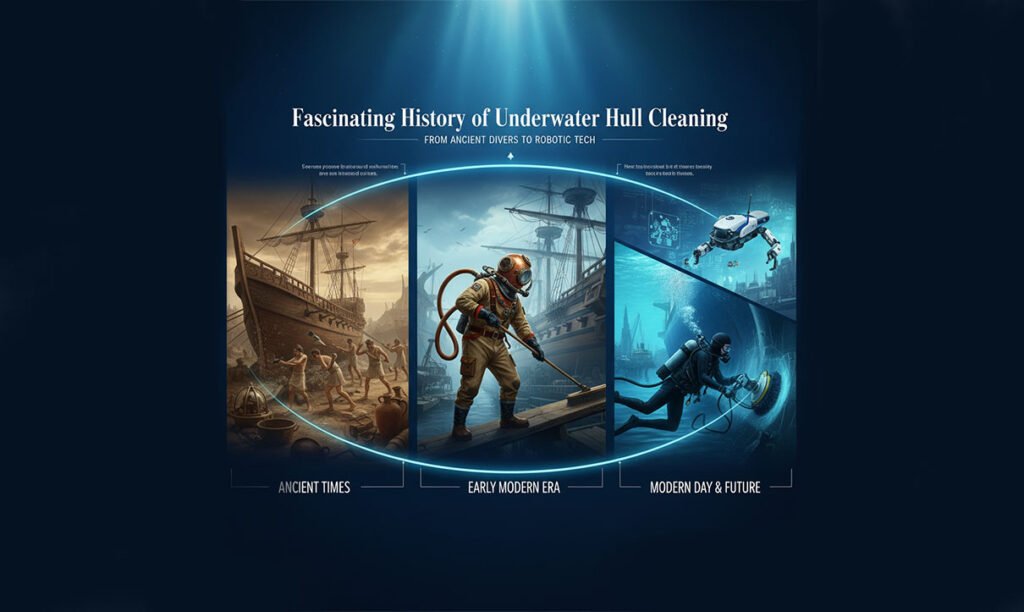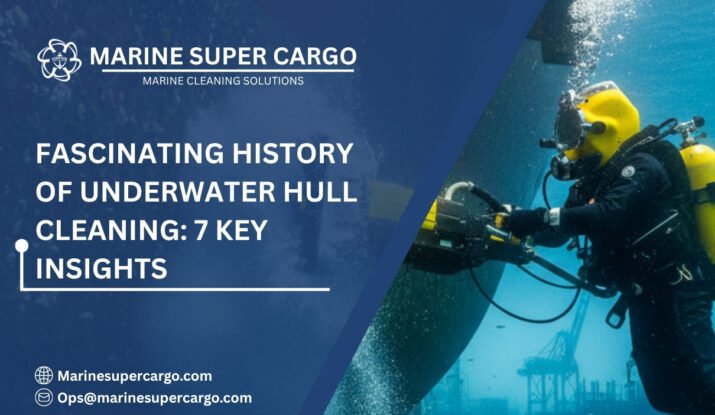Step aboard, and let’s journey into the history of underwater hull cleaning, a saga that merges ancient ingenuity and modern innovation. Imagine your ship’s hull as the heart of your vessel—when it’s burdened, your whole fleet slows, yet when it’s cared for, your operations soar. As we dive deep into this story, you’ll discover seven key insights that shape how we clean, conserve, and comply, blending past lessons with future possibilities.
Whether you’re a curious newcomer or a seasoned ship manager, you’ll find practical wisdom—and a healthy dose of maritime storytelling—in the chapters ahead.
The History of Underwater Cleaning Technology and Equipment
The journey of underwater cleaning technology dates back centuries, when sailors manually scraped barnacles and algae from wooden ship hulls using primitive tools. These early methods were labor-intensive and risky, often performed by divers with knives, scrapers, or stones.
By the late 19th and early 20th centuries, industrial advances introduced metal scrapers, brushes, and air-supplied diving suits, allowing safer and more effective hull maintenance.
The 20th century saw game-changing innovations: high-pressure water jets, rotating brushes, and hydraulic tools transformed underwater cleaning efficiency. Eventually, specialized ROVs (remotely operated vehicles) and robotic systems replaced much of the diver-based work, offering precision cleaning with minimal human risk.
Today, eco-friendly equipment, non-toxic antifouling solutions, and AI-powered hull cleaning robots represent the latest stage of this technological evolution—balancing efficiency with environmental sustainability.

The Origins: Early Methods and Motivations
The history of underwater hull cleaning begins with civilization’s first ships. Ancient mariners discovered that marine fouling made their wooden hulls sluggish and vulnerable. Lacking modern tools, they relied on brute strength and simple scrapers, sometimes beaching vessels for manual cleaning.
- In Egypt, Greece, and Rome, ship crews used stones and metal blades to remove growth.
- Early cleaning was tedious, often reserved for crucial journeys or urgent repairs.
- Sailors saw hull cleaning as essential for speed, cargo safety, and war readiness.
Much like pruning a vineyard for fruitful returns, early hull cleaning ensured each voyage was worth the journey.
Technological Leaps: From Dry Dock to Diving
The history of underwater hull cleaning leapt forward with new technologies. By the Middle Ages, shipyards emerged, introducing primitive dry docks where ships could be fully exposed for maintenance.
Divers Enter the Scene
As commercial shipping grew, some vessels couldn’t afford long dry-dock stops. Enter the first professional divers—“frogmen”—who used weighted boots and hose-fed helmets to scrape hulls underwater.
- 19th-century reports from the IMO and Marine Insight document how divers risked their lives to fight barnacles and algae with hand tools, underwater lamps, and sheer determination.
- This was more art than science: cleaning schedules varied, and techniques were secretive, handed down between teams.
The work was dangerous but vital. These pioneers laid the foundation for future compliance and safety standards.
Wartime and Industrial Boom: Hull Cleaning’s Strategic Role
History often accelerates in times of crisis. The history of underwater hull cleaning expanded dramatically during the World Wars, when navies realized that dirty hulls spelled disaster for speed and stealth.
- Faster cleaning techniques emerged, with powered brushes and portable pumps.
- Shipyards and marine agencies standardized hull cleaning protocols, demanding regular inspections for combat vessels.
The aftermath saw an industrial boom: commercial fleets, oil tankers, and cargo ships all demanded efficient underwater cleaning for cost savings and reliability.
Read also: The world’s oldest port in Egypt and the history of underwater hull cleaning in the region.
Regulatory Revolution: MARPOL, IMO, and Compliance
Underwater hull cleaning became not only an industry staple but a matter of law. The history of underwater hull cleaning intertwines deeply with MARPOL Annex VI and IMO regulations.
- Since the 1970s, international bodies have urged regular cleaning to reduce drag, boost energy efficiency, and curb greenhouse gas emissions.
- The International Association of Ports and Harbors (IAPH) encouraged responsible practices to protect local ecosystems.
- Compliance became central—clean hulls were not simply good for business, but crucial for legal operation.
Technical Jargon Explained: Biofouling
“Biofouling” means the build-up of microscopic and visible marine organisms (such as algae, barnacles, and mussels) on a ship’s hull. This increases friction, fuel consumption, and emission rates.
Cost-Saving Implications
Fouled hulls burn more fuel and accrue higher maintenance costs. Regular cleaning can save ship owners thousands annually—an insight transforming maintenance strategies worldwide.
The Age of Innovation: Robotics and Eco-Friendly Solutions
The modern history of underwater hull cleaning is shaped by innovation. Gone are the days when divers alone ruled the waves.
- Robotic hull cleaning systems now deliver precise, safe scrubbing without human risk.
- Eco-friendly cleaning methods minimize harm to hull coatings and local waters, aligning with CleanShip.co’s sustainability benchmarks.
Insights into Automated Cleaning
Robots use cameras, magnetic tracks, and specialized brushes to efficiently remove biofouling. Their work can be monitored by crews from the safety of the deck, and results are logged for compliance audits.
Smart Monitoring for Future Trends
Digital hull monitoring predicts optimal cleaning intervals by measuring roughness and analyzing biofouling accumulation—helping managers make data-driven decisions.
Environmental Impact: Protecting Our Oceans
Throughout the history of underwater hull cleaning, the balance between efficiency and environmental stewardship has evolved. Today, cleaning practices must protect marine life as well as ships.
- IMO and IAPH advocate for biofouling management to prevent the spread of invasive species and protect biodiversity.
- Regulations now require waste capture and proper disposal of fouling material from hull cleaning.
- Sustainable cleaning supports compliance with global emission standards, contributing to a greener shipping industry.
Cleanship.co and Marine Supercargo: Smarter Marine Cleaning Solutions
Cleanship.co is a leading Indian provider specializing in cargo hold and tank cleaning, offering eco-friendly underwater hull cleaning to cut drag and elevate vessel efficiency. Based in Mumbai, they follow strict safety and environmental standards through a structured four-step process—appraising, planning, execution, and monitoring—to ensure spotless and compliant operations.
Marine Supercargo is a global platform connecting vetted cleaning vendors across 1,100+ ports. It streamlines hold, tank, and hull cleaning by simplifying communication, reducing downtime, and ensuring compliance.
Case Studies: Lessons from Industry Leaders
Stories from real fleets amplify the insights gained across the history of underwater hull cleaning.
- Marine Insight chronicles how scheduled cleaning programs reduced one tanker’s fuel bills by 35%, with faster transits and improved port records.
- CleanShip.co’s case studies highlight the transformative effect of eco-robotic cleaning, linking energy savings to stronger compliance ratings.
- The best results? Teams that treat hull cleaning as an investment, not a burden.
Conclusion
The history of underwater hull cleaning is a story of adaptation and innovation—from ancient scrapers to advanced robotics, it’s a journey defined by risk, reward, and responsibility. We’ve seen how cleaning improves compliance, cuts costs, and preserves the oceans we traverse. As shipping prepares for tomorrow’s challenges, one thing is clear: investing in hull cleaning means investing in the future. Ready to modernize your fleet? Make CleanShip.co your partner and unlock lasting benefits.
FAQs:
Q1. What is biofouling in the context of underwater hull cleaning?
Biofouling refers to the accumulation of marine organisms on a ship’s hull. In the history of underwater hull cleaning, controlling biofouling is crucial for efficiency and compliance.
Q2. How did early shipowners clean their hulls before diving technology?
In the history of underwater hull cleaning, shipowners scraped hulls using stones and simple blades, sometimes beaching vessels for manual cleaning—a labor-intensive but essential task.
Q3. What are the latest innovations in hull cleaning?
The latest innovations in the history of underwater hull cleaning include robotic cleaning systems and digital hull monitoring, improving safety and environmental outcomes.
Q4. How does underwater hull cleaning affect ship performance?
Clean hulls reduce drag, fuel consumption, and emissions. The history of underwater hull cleaning shows that timely cleaning is central to speed, compliance, and cost savings.
Q5. Why is compliance important in hull cleaning practices?
The history of underwater hull cleaning shows that compliance with MARPOL, IMO, and IAPH ensures ships meet environmental standards, avoid fines, and maintain operational continuity.


